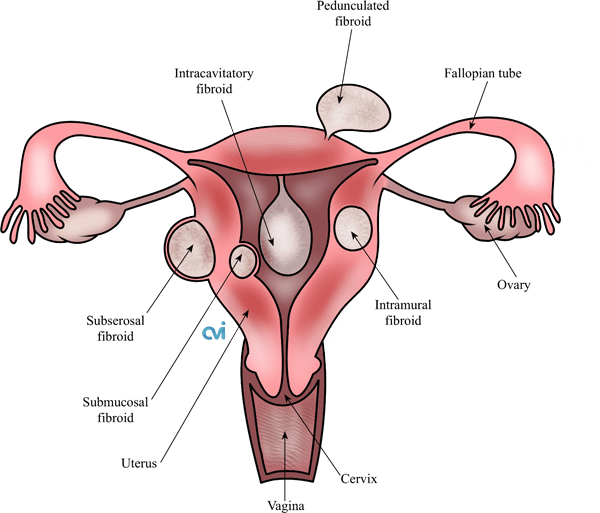Long-Term Risks of Untreated Uterine Fibroids
Uterine fibroids, or leiomyomas, are common benign tumors that develop within the uterine wall. While many fibroids are asymptomatic and require no treatment, untreated uterine fibroids can pose long-term risks and complications.
Increased Symptom Severity and Impact on Quality of Life:
Untreated uterine fibroids can lead to a progressive worsening of symptoms over time. Menorrhagia (excessive menstrual bleeding), pelvic pain, pressure, and discomfort can become more severe, resulting in significant physical and emotional distress1. The ongoing impact on quality of life can affect daily activities, work productivity, and overall well-being.
Chronic Anemia and Iron Deficiency:
Persistent heavy menstrual bleeding caused by uterine fibroids can lead to chronic anemia and iron deficiency if left untreated. Anemia can cause fatigue, weakness, shortness of breath, and reduced physical endurance. Iron deficiency further exacerbates these symptoms and affects overall health and vitality.2,3
Infertility and Pregnancy Complications:
Uterine fibroids can interfere with fertility and increase the risk of pregnancy complications. Fibroids can distort the uterine cavity, disrupt implantation, and compromise the blood supply to the developing fetus. This can result in infertility, recurrent miscarriages, preterm labor, and complications during pregnancy such as placental abruption and fetal growth restriction.4,5 Treating fibroids before attempting to conceive or during pregnancy can help mitigate these risks and improve reproductive outcomes.
Uterine Enlargement and Compression of Adjacent Structures:
As uterine fibroids grow larger, they can cause the uterus to expand in size. This can lead to compression of adjacent structures, including the bladder and the intestines. Compression of the urinary bladder can cause frequent urination, urgency, and urinary retention. Fibroids pressing on the rectum may result in constipation or difficulty with bowel movements. Addressing fibroids early on can prevent the long-term effects of organ compression and associated complications.6,7
Chronic Pain and Pelvic Pressure:
Long-term untreated uterine fibroids can result in persistent chronic pain and pelvic pressure. Fibroids can cause discomfort and pain, leading to decreased quality of life and interference with daily activities. The continuous pressure on surrounding organs can contribute to ongoing pelvic discomfort and lower abdominal pain.8
Development of Complications and Adverse Events:
Untreated uterine fibroids can give rise to various complications and adverse events. Fibroids can undergo degenerative changes, such as hyaline degeneration or necrosis, leading to acute pain and necessitating emergency medical attention. Large fibroids can increase the risk of torsion or necrosis, which may require immediate surgical intervention. Additionally, the presence of untreated fibroids may complicate subsequent surgical procedures, making them more challenging and increasing the risk of intraoperative or postoperative complications.9,10
Impact on Sexual Function and Intimate Relationships:
The presence of untreated uterine fibroids can have a negative impact on sexual function and intimate relationships. Fibroids can cause discomfort, pain, and pressure during sexual intercourse, leading to decreased sexual desire and satisfaction. Addressing fibroids through appropriate treatment can alleviate these symptoms, restore sexual function, and improve overall sexual well-being.11
Psychological and Emotional Consequences:
Living with untreated uterine fibroids can have long-term psychological and emotional consequences. The chronic pain, unpredictable bleeding patterns, fertility concerns, and compromised quality of life can contribute to anxiety, stress, depression, and decreased overall psychological well-being. Treating fibroids can alleviate these emotional burdens and improve mental health outcomes.12
Decreased Treatment Options
While fibroids are monitored by ultrasound, they are guaranteed to grow over time. As these fibroids grow the treatment options become limited and more complex due to the size and possible increased vascularity. E.g., larger fibroids then require open surgery when previously it could have been treated laparoscopically. Similarly, non-surgical UFE may be more complex to do or take longer post op to see symptom improvement. A very large fibroid uterus can start to recruit and steal blood flow from other organs, eg the liver and spleen. This makes surgical treatments very dangerous as these vessels can be cut unexpectedly leading to life threating blood loss during surgery. Non-surgical embolization may be required several times to close off all these channels before UFE or surgery can be performed.
Long-Term Risks of Fibroids
Untreated uterine fibroids pose various long-term risks and complications. From the progressive worsening of symptoms and chronic anemia to fertility issues, pregnancy complications, chronic pain, and adverse events, the consequences of untreated fibroids can be substantial. Early diagnosis, appropriate monitoring, and timely intervention are crucial for optimizing long-term outcomes and preserving a woman’s overall health, well-being, and quality of life.
Uterine Fibroid Embolization (UFE)
UFE can help you get your life back without any scarring or hospital stay. It can reduce the size of your fibroids, relieve your symptoms, and retain your fertility. Most women can return to their normal activities in two to seven days.
How is the UFE Performed?
- You will receive twilight sedation to help you relax
- Our specialist numbs the skin on the wrist or groin
- A tiny catheter is placed
- Small beads are placed into the fibroid artery
- The catheter is removed
- Band-Aid is applied
- Recover at home
Some of the UFE advantages include:
- No hospital stay
- No general anesthesia
- No stitches
- No blood loss
- No risk of hysterectomy
- No major scars
- No surgical risks
We are Here to Help
Request an appointment to meet with our fibroid specialist who will review your imaging, labs and history to determine if you are candidate for the procedure, and the outcomes you can expect. Each woman is an individual and should discuss the potential risks and benefits of fibroid embolization and other treatments with our doctor to decide which option is best for her.
Appointments are available via an online video telehealth platform or in person at one of the offices in Los Angeles, Orange County or San Diego. Why should you choose us? Read here.
- Stewart EA. Uterine fibroids. N Engl J Med. 2015;372(17):1646-1655.
- Marsh EE, Al-Hendy A, Kappus D, Galitsky A, Stewart EA, Kerolous M. Burden, prevalence, and treatment of uterine fibroids: a survey of US women. J Womens Health (Larchmt). 2018;27(11):1359-1367.
- Gupta S, Jose J, Manyonda I. Clinical presentation of fibroids. Best Pract Res Clin Obstet Gynaecol. 2008;22(4):615-626.
- Somigliana E, Vercellini P, Daguati R, Pasin R, De Giorgi O, Crosignani PG. Fibroids and female reproduction: a critical analysis of the evidence. Hum Reprod Update. 2007;13(5):465-476.
- Lieng M, Berner E, Busund B. Prevalence of adenomyosis diagnosed by transvaginal ultrasound in women with infertility. Acta Obstet Gynecol Scand. 2015;94(9):989-994.
- Magon N, Kandpal S. Urinary problems in females with large uterine fibroids. Int J Gynaecol Obstet. 2011;115(2):194-195.
- Wolanske KA, Gordon RL, Olsen D, et al. Uterine artery embolization: where do we stand in 2002? J Vasc Interv Radiol. 2002;13(10):1085-1095.
- Gupta JK, Sinha A, Lumsden MA, Hickey M. Uterine artery embolization for symptomatic uterine fibroids. Cochrane Database Syst Rev. 2014;(12):CD005073.
- Gupta JK, Sinha A, Lumsden MA, Hickey M. Uterine artery embolization versus surgical treatment for symptomatic uterine fibroids. Cochrane Database Syst Rev. 2014;(12):CD005073.
- Park JY, Park SK, Kim DY, Kim JH, Kim YM, Kim YT, Nam JH. The impact of tumor morcellation during surgery on the prognosis of patients with apparently early uterine leiomyosarcoma. Gynecol Oncol. 2011;122(2):255-259.
- Berman JM. Sexual function and fertility quality of life in women using magnetic resonance-guided focused ultrasound and uterine artery embolization for symptomatic fibroids. J Minim Invasive Gynecol. 2011;18(6):802-808.
- De La Cruz MS, Buchanan EM. Uterine fibroids: diagnosis and treatment. Am Fam Physician. 2017;95(2):100-107.









